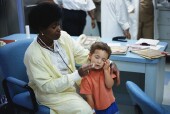Four meds caused 91.2 percent of visits for over-the-counter liquid medication exposures
WEDNESDAY, Sept. 9, 2015 (HealthDay News) — The number of pediatric emergency department visits for medication exposures in children aged 6 years and younger rose during the early 2000s, peaking at 75,842 in 2010, but declined to 59,092 visits in 2013, according to findings published online Sept. 7 in Pediatrics.
Between 2004 and 2013, 640,161 children aged 6 and younger were seen in emergency departments for ingesting drugs. Of these, 70 percent were 1- or 2-year-olds, and nearly one in five were hospitalized, according to the report. Between 2010 and 2013, 91 percent of emergency department visits involved ingestion of one medicine. Nearly half involved prescription pills, tablets, or capsules. Almost a quarter involved over-the-counter pills, tablets, or capsules, lead researcher Maribeth Lovegrove, M.P.H., of the U.S. Centers for Disease Control and Prevention’s Division of Healthcare Quality Promotion, told HealthDay. In addition, 12.4 percent of visits involved an over-the-counter liquid medicine, such as cough syrup.
Four medications caused 91.2 percent of the emergency department visits for over-the-counter liquid medication exposures; 87 percent children’s or infants’ versions, Lovegrove said. The medications were: acetaminophen (32.9 percent of visits); cough and cold medicines such as Robitussin and Delsym (27.5 percent of visits); ibuprofen (15.7 percent of visits); and diphenhydramine (15.6 percent of visits).
“In contrast, more than 260 different prescription pills, typically intended for adults, were involved in emergency department visits for unsupervised exposures in young children,” Lovegrove said. The most common ones were opioids, such as buprenorphine, oxycodone, or hydrocodone. Those were involved in 13.8 percent of visits. They were followed by benzodiazepines, including clonazepam (Klonopin) and alprazolam (Xanax), which were involved in 12.7 percent of visits.
Abstract
Full Text (subscription or payment may be required)
Copyright © 2015 HealthDay. All rights reserved.








